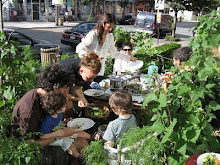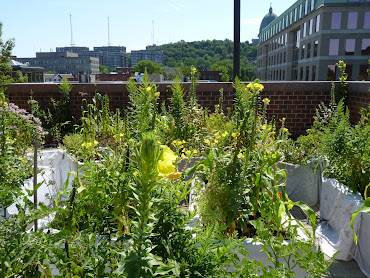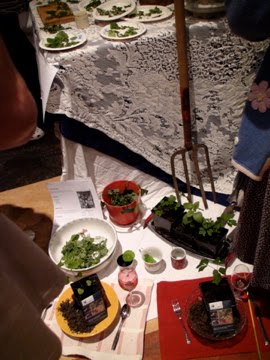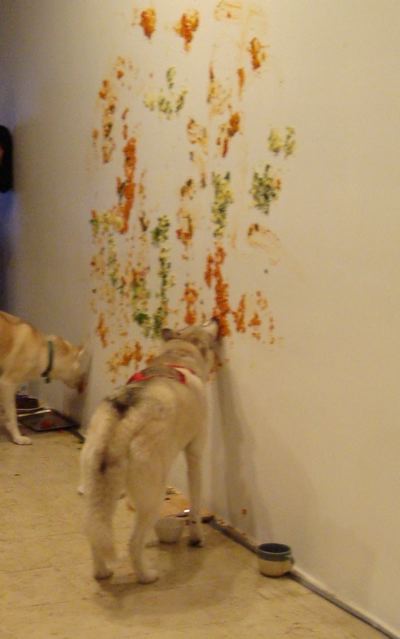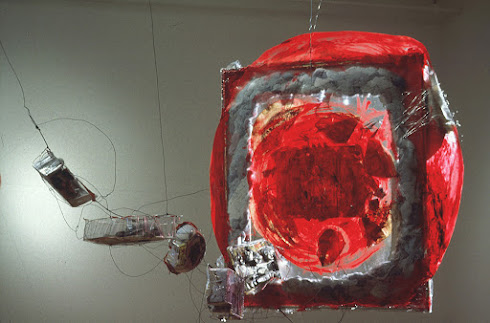(See english below, after french)
Biographie démarche artistique
Arts visuels, Interdisciplinarité, Performance, Art Public engagé / Pratique artistique sociale et environnementale
Nicole McDonald-Fournier (Nicole Fournier, avant 2018), est une artiste interdisciplinaire et visuelle née et vivant à Montréal, Québec. Ses origines sont aux Antilles, aux Petites Antilles de Trinité-et-Tobago, d'Antigua-et-Barbuda et de Saint-Kitts, dans les Caraïbes du côté de sa mère (McDonald) et à Huntingdon, dans la région de la Montérégie au Québec et dans le quartier du Mile End, Ville de Montréal. , Québec, Canada, du côté de son père (Fournier).
Son parcours est en Arts Visuels. Elle
a commencé l'art de la performance en 1988 en parallèle de ses
activités de peintre. Depuis 1996, elle développe, ses création et les contextes, qui se réalisent par et avec son approche
agro-écologique de jardinage et d'agriculture à petite échelle. Elle se voit dans le rôle d'intendante de la terre (en anglais "steward of the land") pour le soutien de paysages vivants et riches en
biodiversité qui sont gérés écologiquement et intégrés aux vies humaines
pour la santé. Elle a évolué par un art social et environnemental, dans les dernières vingtaine d'années (débutant entre 2001 et 2005) par ses oeuvres art public et performance in situ, engagé dans des lieux urbains, résidentiels, lieux agricoles et lieux dédiés à l’Art, avec des résidents et artistes, des organismes communautaires, publics et privés.
Ces œuvres sont réalisées avec diverses composantes, à travers l'installation, la sculpture, la performance, l'art conceptuel, le dessin/peinture, utilisant notamment une biodiversité de plantes, arbustes et arbres (vivants et séchés) et de multiples matériaux de récupération (textiles, meubles et autres).
Surtout les dessins, peintures, sont réalisés à partir de plantes
comestibles fraîchement récoltées, séchées et accumulées et des fois les restants de salads. Inscrire et informer les sources (origines) des matériaux (et si possible, comment elle sont faites), fait partie de la réalisation et présentations de ses oeuvres.
Sa démarche inclut observation et ne pas agir, « do nothing », ainsi que de petit actions d'intervention écologique, pour que les plantes et écosystèmes maintiennent leur propre autonomie « non contrôlée», par les humains, le plus possible, pour que les plantes et leurs écosystèmes gardent « leur liberté de maintenir leur biodiversité » dans les paysages urbains, suburbains ou ruraux. Cela se compare aux paysages de très grand agriculture monoculture qui rendent les sols stérile, par manque de biodiversité. Cette gestion de «do nothing farming» (agriculture faire rien), approche écologique sont à partir desquelles s'articule sa pratique artistique. Son art prend forme à partir de ce que nous considérons ou nommons des gestes « agricoles » tels que planter, récolter, préparer ou composter, réalisés avec une intention consciente et créative. Elle travaille justement à être créative avec ces gestes, incorporant lenteur et non-action, donnant plus de place aux plantes en tant qu'interprètes et leur laisant décider où elles poussent.
A travers une pratique d'actions performatives qui peuvent inclure de la médiation, spontanée ou planifiée avec des partenaires communautaires. Le résultat des processus de performance longue durée, médiations, et avec les interaction avec le public peuvent devenir de la
photographie et la vidéo et des blogs-sitewebs.
Ainsi le dessin, la
peinture, l'assemblage et l'impression deviennent la photo et vidéo dans leur évolution de pigment vivantes, réalisés à partir de plantes
comestibles fraîchement récoltées et de restes de repas et autres
nouvelles matières en exploration qui inclut ou non des matériaux synthétiques.
Autres qualité de son art public et art conceptuel est l'invisible des performance des bioremédiations par les plantes et leurs écosystems dans ses oeuvres, surtout celles du projet EmballeToi!
Elle a réalisé des projets collaboratifs, dans divers contextes communautaires, aussi bien que cuisine-salle à manger extérieur intégrée avec les plantes et légumes, qu'elle appelle « Live Dining », ses actions et non-actions peuvent ou ont l'intention de faciliter l'intérêt aux écosystèmes, résultant d’une démarche de sensibilisation à la biodiversité, souvent ignorée.
MdDonald-Fournier a exposé et réalisé des résidences et performance aux États Unis, en Italie, France, Mexique et Portugal, ainsi dans les centres d'artistes au Québec et au Canada, dont La Centrale Powerhouse, le centre Articule, Verticale et Latitude 53. Son travail est soutenu par l’organisme sans but lucratif, InTerreArt, fondé en 2008. InTerreArt a réalisé des projet de nature "Sculpture sociale", avec McDonald-Fournier en tant que commissaire et directrice artistique, en invitant des artistes en 2010, 2017-2019 et 2023-24, sous divers formes de réalisations d'oeuvres et ateliers participatifs et collaboration entre artistes et par multiples actions, en partenariat avec des organismes communautaires et environnementaux, ainsi qu'en collaboration directe avec les voisins et les citoyens. L'organisme est partenaire de la Ville de Montréal pour son Plan de développement durable et soutient l'Agenda21C du gouvernement du Québec. Fournier est titulaire d'un baccalauréat en beaux-arts de l'Université Concordia (1993) et d'un diplôme d'études supérieures en études environnementales de l'Université McGill (2005).
En 2012, Linda Weintraub, conservatrice et théoricienne de l'art contemporain new-yorkais, fait référence à elle dans la section sur les explorateurs de l'éco-art du 21e siècle, à propos du « Live Dining », dans son livre To Life ! Eco Art à la poursuite d'une planète durable, publié par University of California Press.
McDonald-Fournier habite sa maison et terrain depuis 1996, ça fait 28 ans. Il a eu 2 transformations en permaculture et pour laisser la biodiversité accroître sur le terrain : un dans l'arrière-cour en 2005 avec «Live Dining» et la deuxième en 2010 avec l'action collective. Depuis 2018, le terrain a été certifié par Le jardin botanique - Espace pour la vie - Montréal et a gagné le prix de la biodiversité de l’arrondissement Saint-Laurent en 2017. Ce lieu résidentiel privé est aussi le siège social de l’organisme à but non lucratif InTerreArt pour réaliser des projets qui reflètent sa pratique artistique d’un art interdisciplinaire et intersectoriel. InTerreArt est son moyen pour développer des partenariats avec des résidents, des organismes communautaires et l’arrondissement. Ce terrain pour des performances-créations où le trottoir devient un lieu de rencontres et d’échanges. Ce terrain est une œuvre écologique, représentative de son art, en évolution, qui se réalise par des performances relationnelles, de l’art participatif avec des œuvres vivantes, éphémères et également permanentes. (voir article du Devoir de Marie-Ève Charron, le 21 août 2021 https://www.ledevoir.com/culture/arts-visuels/626190/serie-l-atelier-c-est-l-oeuvre-histoires-de-famille-et-de-transmission)
Biography art statement
Visual Arts, Interdisciplinarity, Performance, Engaged Public art / Social and environmental art practice
Nicole
McDonald-Fournier (Nicole Fournier - for artworks, publications etc
prior to 2018), is an interdisciplinary and visual artist born and
living in Montréal, Québec. Her origins are in the West indies, Lesser
Antilles Trinidad and Tobago, Antigua and Barbuda, and Saint Kitts, in
the Caribbean on her mother's side (McDonald) and in Huntingdon, the
Montérégie region of Québec, and Mile End neighbourhood, City of
Montréal, Québec, Canada, on her father's side (Fournier).
Her
background is in Visual Arts in painting, sculpture, performance and
conceptual art. She began performance art in 1988 alongside being a
painter. Since 1996, she has been developing an agro-ecology, small
scale gardening-farming approach based in being a steward and supporting
living biodiverse landscapes that are ecologically managed and
integrated with human lives for global health, and that maintain their
own autonomous “not controlled by humans" freedom to maintain their
biodiversity within the landscapes of either urban, suburban or rural
landscapes, leaving wildness alone. This compares to or as opposed to
monoculture landscapes leave barren the soil and where there is no
biodiversity and is an open air factory farm. This stewardship and
eco-responsibility is from which her entire artistic practice is
articulated. Her art takes shape from what we consider or name
"agricultural" gestures such as planting, harvesting, preparing or
composting, done with a mindful and or creative intention. She works to
be creative with these gestures, incorporating slowness and non-actions,
giving more place to the plants as performers and having them decide
where they grow. Through a practice of mediation and performative
actions, drawings made of organic medium, participatory projects with
diverses community contexts and kitchen-dining-room (with plants and
vegetables) that she calls "Live Dining”, her actions and non-actions
facilitate the development of ecosystems resulting from an
awareness-raising approach to biodiversity, which is often ignored.
Her
art practice exist both as an interdisciplinary visual art practice and
a social and environmental engaged art practice that are both realized ,
seperately and together. That is, both exist together and nourrish
each other, as McDonald-Fournier works back and forth, needing the
solitary time to nourrish the collective time working with communities
and residents / citizens directly, within environmental and ecological
contexts, with the intent to benefit all and Nature - biodiversity, the
land that feeds and nourrishes us all.
Her performance and
process art is expressed through photography and vidéo, sculpture and
installation, drawing, painting, "assemblage" and print, made from
freshly harvested edible plants and leftover meals.
MdDonald-Fournier has exhibited and carried out residencies and performances in the United States, Italy, France, Mexico and Portugal, and has taken part and exhibited in artist-run centres in Quebec and in
Canada, such as La Centrale Powerhouse, Articule, Verticale and Latitude
53. Her work is supported by the non-profit organization, InTerreArt, founded in 2008. InTerreArt has carried out projects of a "Social Sculpture" nature, with McDonald-Fournier as curator and artistic director, inviting artists in 2010, 2017-2019 and 2023-24, in various forms of creation of works and participatory workshops and collaboration between artists and through multiple actions, in partnership with community and environmental organizations, as well as in direct collaboration with neighbors and citizens. The organization is a partner of the City of Montreal for its Sustainable Development Plan and supports the Government of Quebec's Agenda21C. Fournier holds a Bachelor of Fine Arts from Concordia University (1993) and a graduate diploma in environmental studies from McGill University (2005).
In 2012, Linda Weintraub, a New York contemporary art curator and theorist, referred to her in the section on 21st century eco-art explorers, regarding "Live Dining", in her book To Life! Eco Art in Pursuit of a Sustainable Planet, published by University of California Press.
McDonald-Fournier has lived in her house and land since 1996, that's 28 years. There has been 2 transformations into permaculture, to let biodiversity increase on the land: one in the backyard in 2005 with “Live Dining” and the second in the frontyard, in 2010 through a collective action. Since 2018, the land has been certified by The Botanical Garden - Espace pour la vie - Montreal and won the biodiversity prize of the Saint-Laurent borough in 2017. This private residential place is also the head office of the organization non-profit, InTerreArt, to carry out projects that reflect its
interdisciplinary and intersectoral mission and mandate, in contemporary art practice, coming out of visual arts, and what in french is called "art actuel" and in performance art "art vivant". InTerreArt works in partnerships with residents, community organizations and the borough. This land "terrain" is a site for performance-creations where the sidewalk becomes a place for meetings and exchanges. The land is an ecological work, representative of its art, in evolution, validating other species and ecosystem performances, and which is realized through relational performances, participatory art with living, ephemeral and also permanent works. (see article in Le Devoir by Marie-Ève Charron, August 21, 2021 (in french only) https://www.ledevoir.com/culture/arts-visuels/626190/serie-l-atelier-c-est-l-oeuvre-histoires-de-family-and-transmission)
McDonald-Fournier's work is supported by the not-for-profit organization
InTerreArt, which she founded in 2008. InTerreArt engages multiple
actions in partnership with community and environmental organizations,
as well as in direct collaboration with neighbours and citizens. The
organization is a partner of the City of Montreal for its Sustainable
Development Plan and it supports the Agenda21C from the Quebec
Government. Fournier holds a B.F.A from Concordia University 1993, and a
graduate degree in Environmental Studies from McGill University 2005 .
In
2012, Linda Weintraub, curator and theoretician of New York
contemporary art, refers to her in the section on 21st-century eco-art
explorers, about "Live Dining", in her book To Life! Eco Art in Pursuit
of a Sustainable Planet, published by University of California Press.
